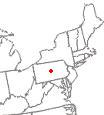|

Jersey Shore, PA | The following is pasted from an email newsletter I receive from Penn State U. Talking about the "beer can" ears. I have not walked enough fields to know if this is a widespread problem on our farm, but do know of one field where is looks fairly severe.....both on the strip that headline was applied and elsewhere. In a couple other fields I did not notice it as severely. Interesting about the temperature effect......did not know that could be a problem. Last sample I pulled was still 32% moisture last week. Dry weather and upper 70's low 80's this week should help. Bean leaves are dropping now.
Scott
We have seen sporadic cases of blunt ears or “beer can ears” in the past in Pennsylvania and this year there have been reports of this phenomenon occurring this year and throughout the Midwest as well. Recently I visited several fields with a crop consultant and observed perhaps the most severe symptoms that I have seen to date. The incidence of these symptoms in the field was also quite high, ranging up to 70-80% in one field.
Several fields we visited had what I would call the typical blunt ear symptoms, with plants that appeared normal, with normal husks, but then inside the husk was an ear that ranged from 30 to 60 percent of normal. http://fcn.agronomy.psu.edu/images/roth0729image3.jpg Unlike typical drought stressed corn, the cob development was arrested, apparently early in the development of the ear. Often ears have a rudimentary ear shoot on the end of the ear.
This year, we found more serious cases of this arrested ear development than we have seen before. On these ears, only a very short ear with a few ovules http://fcn.agronomy.psu.edu/images/roth0729image2.jpg or even only a tiny ear shoot developed http://fcn.agronomy.psu.edu/images/roth0729image4.jpg . In our fields some of the severe plants had an unusual white flashing above the collar on upper leaves. http://fcn.agronomy.psu.edu/images/roth0729image1.jpg Crop records on the fields indicated adequate to high soil nutrient levels, recommended herbicide programs, no fungicide applications, and no unusual practices. According to the consultant, there seemed to be some hybrids that were more prone to the problem, but it was not consistent.
My colleague, Bob Nielsen, at Purdue University, has been finding the same problem in Indiana and has written a good summary of the symptoms and potential causes of the problems (http://extension.entm.purdue.edu/pestcrop/2007/issue23/index.html). Bob suggests the normal blunt ear symptoms may be associated with dramatic changes in temperature or a cold temperature shock during ear development. He has suggested that the more severe arrested ear development symptoms may be associated with post emergent herbicide, fungicide or other chemical applications near the V12 stage.
In our fields, the only issue that seems to be consistent with these potential causes is the dramatic change in temperature. On June 9, a high of 90 F occurred, followed by lows of 53 and 48 on June 10 and June 11. Also, on June 20 we had a high of 87 F followed by lows of 53 and 47 on June 21 and 22.
| |
|


 Blunt ears in corn fields
Blunt ears in corn fields